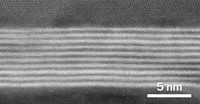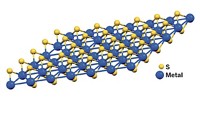Advertisement
Grab your lab coat. Let's get started
Welcome!
Welcome!
Create an account below to get 6 C&EN articles per month, receive newsletters and more - all free.
It seems this is your first time logging in online. Please enter the following information to continue.
As an ACS member you automatically get access to this site. All we need is few more details to create your reading experience.
Not you? Sign in with a different account.
Not you? Sign in with a different account.
ERROR 1
ERROR 1
ERROR 2
ERROR 2
ERROR 2
ERROR 2
ERROR 2
Password and Confirm password must match.
If you have an ACS member number, please enter it here so we can link this account to your membership. (optional)
ERROR 2
ACS values your privacy. By submitting your information, you are gaining access to C&EN and subscribing to our weekly newsletter. We use the information you provide to make your reading experience better, and we will never sell your data to third party members.
Materials
Graphene Eyed As The Next Big Thing In Carbon-Based Electronics
by Bethany Halford
April 17, 2006
| A version of this story appeared in
Volume 84, Issue 16

APS Meeting News
Move over carbon nanotubes, there's a new allotrope in town. A flat, single layer of graphite known as graphene is shaking up the physics world. The material could soon be the basis for a new wave of nanometer-scale electronic devices, surpassing similar technology based on its tube-shaped brethren.
For more than 50 years, theories have predicted that carbon in the form of graphene could exist, but it wasn't until 2004 that Andre K. Geim and coworkers managed to produce the material experimentally by repeatedly peeling layers off highly oriented pyrolytic graphite (C&EN, Oct. 25, 2004, page 16).
Geim, a physics professor at the University of Manchester, in England, said the material has opened up a new realm of physics. "It's the first material that mimics the relativistic world," Geim explained, adding that even at room temperature, electrons can move quickly through the material with little energy dissipation.
Graphene and carbon nanotubes have the same remarkable electronic properties, added Walt de Heer, a longtime nanotube researcher at Georgia Institute of Technology. Both can conduct electrons with virtually no resistance, and they both can be tuned to behave like a metal or a semiconductor. De Heer, however, thinks graphene holds greater promise for electronics because it's possible to produce the material in consistently good quality and it should be easy to process graphene layers by established microelectronics manufacturing techniques.
"Nanotubes are simply graphene that has been rolled into a cylindrical shape," de Heer explained. "Using narrow ribbons of graphene, we can get all the properties of nanotubes because those properties are due to the graphene and the confinement of the electrons, not the nanotube structures."
De Heer and his team have developed a new method for fabricating graphene. They heat a silicon carbide wafer under high vacuum. This process drives silicon atoms off the surface, leaving behind a thin, continuous layer of graphene. They have used this material to create proof-of-principle transistors, loop devices, and circuitry.
Advertisement
"Our ultimate goal is integrated electronic structures that work on diffraction of electrons rather than diffusion of electrons. This will allow the production of very small devices with very high efficiencies and low power consumption," de Heer said. "We have taken the first step on a very long road."




Join the conversation
Contact the reporter
Submit a Letter to the Editor for publication
Engage with us on Twitter